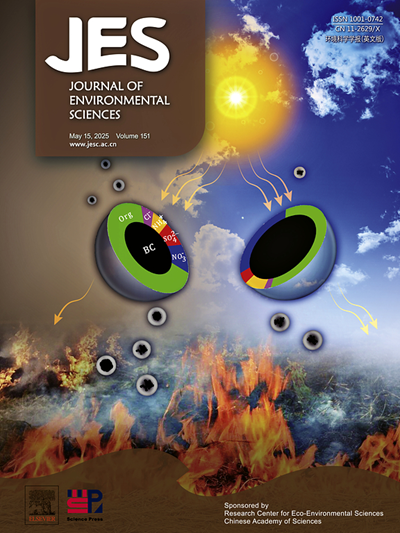Driving role of acid mine drainage on microbial community assembly and species coexistence in paddy soil profiles
IF 5.9
2区 环境科学与生态学
Q1 ENVIRONMENTAL SCIENCES
引用次数: 0
Abstract
The environmental impacts of acid mine drainage (AMD) from open-pit mining are profoundly detrimental, yet knowledge about its effects on paddy soil microbial communities, especially at greater depths, remains limited. In this investigation, we compared soils affected by AMD versus unaffected soil depth profiles in terms of bacterial diversity and community assembly. The profiles in AMD-polluted soils exhibited tight geochemical gradients, characterized by increased acidity, SO42-, NO3-, and heavy metal content compared to unpolluted soils. Notably, AMD significantly diminished soil bacterial biodiversity. A depth-wise analysis showed distinct microbial stratification, with certain bacteria like Candidatus_Solibacter and Candidatus_Koribacter predominated in polluted soils, while others like Haliangium and Nitrospira were more prevalent in control soils. Interestingly, despite variable soil conditions, predicted metabolic pathways, particularly those involving carbon, nitrogen, and sulfur, showed relative stability. AMD pollution induced the upregulation of methyl-coenzyme M reductase and sulfate reductase genes. Bacterial communities were more responsive to pH and nutrient content rather than heavy metals, with pH and SO42- being the primary drivers of microbial diversity and distribution. Additionally, pH was identified as the most significant influence on the predicted methane, sulfur, and nitrogen metabolism. Furthermore, deterministic processes played a more significant role in community assembly of polluted soils, while heterogeneous selection gained importance with increasing depth in control soils. Additionally, microbial co-occurrences, particularly positive interactions, were more prevalent in the polluted soils with reduced network modularity and keystone taxa. These findings offer insights into sustaining microbial diversity in extreme environments.

酸性矿井水对水稻土剖面微生物群落组合及物种共存的驱动作用
露天矿酸性矿井水(AMD)对环境的影响是非常有害的,但对其对水稻土微生物群落的影响,特别是在更深的深度,仍然是有限的。在这项调查中,我们比较了受AMD影响的土壤与未受AMD影响的土壤深度剖面的细菌多样性和群落组合。与未受amd污染的土壤相比,amd污染土壤的地球化学梯度较紧,酸度、SO42-、NO3-和重金属含量均明显增加。值得注意的是,AMD显著降低了土壤细菌多样性。深度分析显示微生物分层明显,在污染土壤中以Candidatus_Solibacter和Candidatus_Koribacter为主,而在对照土壤中以haaliangium和Nitrospira为主。有趣的是,尽管土壤条件多变,但预测的代谢途径,特别是涉及碳、氮和硫的代谢途径,显示出相对稳定。AMD污染诱导甲基辅酶M还原酶和硫酸盐还原酶基因表达上调。细菌群落对pH和养分含量的响应大于重金属,pH和SO42-是微生物多样性和分布的主要驱动因素。此外,pH对预测的甲烷、硫和氮代谢的影响最为显著。此外,确定性过程在污染土壤的群落聚集中起着更重要的作用,而异质性选择在对照土壤中随着深度的增加而变得重要。此外,微生物共生现象,特别是正交互作用,在网络模块化和关键类群降低的污染土壤中更为普遍。这些发现为在极端环境中维持微生物多样性提供了见解。
本文章由计算机程序翻译,如有差异,请以英文原文为准。
求助全文
约1分钟内获得全文
求助全文
来源期刊

Journal of Environmental Sciences-china
环境科学-环境科学
CiteScore
13.70
自引率
0.00%
发文量
6354
审稿时长
2.6 months
期刊介绍:
The Journal of Environmental Sciences is an international journal started in 1989. The journal is devoted to publish original, peer-reviewed research papers on main aspects of environmental sciences, such as environmental chemistry, environmental biology, ecology, geosciences and environmental physics. Appropriate subjects include basic and applied research on atmospheric, terrestrial and aquatic environments, pollution control and abatement technology, conservation of natural resources, environmental health and toxicology. Announcements of international environmental science meetings and other recent information are also included.
 求助内容:
求助内容: 应助结果提醒方式:
应助结果提醒方式:


